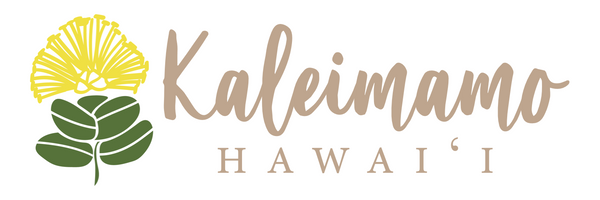ʻIlima
ʻIlima is a shrub indigenous to and commonly found across Hawaiʻi from the shoreline through our mesic forests. Many and varied are the types of ʻilima: ʻilima papa, ʻilima kū kahakai, ʻilima kū kula, ʻilima kuahiwi, and so on. At the shore, ‘ilima is often found sprawling low to the ground, growing only about a foot tall. Some varieties found along the shore have tiny, silver hairs, which help the plant survive in hotter, dryer conditions. In the uplands, ‘ilima grows into medium sized bushes. Areas where ʻilima are known to grow are referred to as the wao ʻilima.


The delicate flowers of the ʻilima are usually orange but can be pale yellow (ʻilima ʻōkea) or even rust red (ʻilima kolikukui). The flowers are edible but rarely consumed today. They can also be used as a mild laxative for babies, called kanakamaikaʻi. ʻIlima flowers, however, are most beloved in lei and a variety with rounded petals was actively cultivated for such use.
An ʻilima lei is a beauty to behold and an honor to receive! Pua ʻilima are picked as buds in the cool hours of the day. As the flowers begin to open/blossom the lei maker prepares to make lei: a cushion on which to lay the pua down; a sharp kui (needle) for stringing them on to the thread; thread for holding the flowers together. Each flower is handled with great care as to avoid damaging the petals during stringing. It can take 500 or more flowers to make one lei. ʻIlima lei are cherished forever.
Nani ka lei ʻilima ke ʻike mai a he mea hiwahiwa e lei ai. ʻAko ʻia ka liko pua i ke anu o ke kakahiaka. Ke mohala aʻe nā pua, ua mākaukau e nā lako kui pua. ʻO ka uluna kahi e hoʻomoe ai ka pua. ʻO ke kui ʻoi loa ka i ʻoi aʻe. A me ka lopi he mea e pono ai. E akahele, e mālama pono i ia mau pua o hoʻopōʻino ʻia i ke kui lei ʻana. Ua lawa paha nā pua ʻelima hanele a ʻoi no ka lei hoʻokahi. He lei hiwahiwa a milimili no nā kau a kau ka lei ʻilima.

A riddle, recorded by Martha Beckwith refers to this process:
Ahiahi, pūʻuluʻulu
Kakahiaka, houhou
Awakea, kau i ka lewa
Gathered and bundled in the evening
Pierced in the morning
Hung from rafters in the forenoon
Lei ʻilima were historically enjoyed by commoners and aliʻi (chiefs), and were a favorite of Queen Emma and Princess Abigail Wahiikaahuula Kawananakoa. According to Marie McDonald, in some areas, strands of ʻilima were worn by farmers during times of planting in the loʻi kalo! Today, they happen to be Pōhai’s favorite and, as such, she’s always keen to include them in all our special occasions. ‘Ilima is also the representative flower of O‘ahu, the home of our family.


Nā Pua Lei ʻIlima by Abbey Palea and Kauʻi Zuttermeister
Nani wale nā pua lei ka ʻilima
ʻO ka uʻi hoʻoheno o Kākuhihewa
Hoʻohihi ka manaʻo lā i laila
Nā pua lei ʻilima e kaulana nei
Kûlana hiehie me ka hanohano
Haʻaheo i ka maka ke ʻike aku
Kaulana nā pua lei ka ʻilima
Ke kikowaena o nā ʻailana
ʻOhuʻohu wale aʻi nā malihini
Ka nani kaulana poina ʻole
Haʻina ʻia mai ana ka puana
Nā pua lei ʻilima e kaulana nei
The lei featured in our photos were lovingly created by John Chock, who also shared much of the manaʻo here, with Hawaiian translation by Kumu Keōmailani Fergerstrom.
This print was created in collaboration with Emily of Kaulumaika. Check out all her work here: https://kaulumaika.com.
